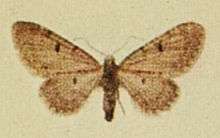Eupithecia distinctaria
| Eupithecia distinctaria | |
|---|---|
 | |
| Scientific classification | |
| Kingdom: | Animalia |
| Phylum: | Arthropoda |
| Class: | Insecta |
| Order: | Lepidoptera |
| Family: | Geometridae |
| Genus: | Eupithecia |
| Species: | E. distinctaria |
| Binomial name | |
| Eupithecia distinctaria Herrich-Schäffer, 1848[1] | |
| Synonyms | |
| |
Eupithecia distinctaria, the thyme pug, is a moth of the family Geometridae. It is found throughout Europe.[2][3][4][5] It is also found in Iran.[6]
The wingspan is 16–20 mm.[3][4][7]The forewing ground colour is light brown. There is a dark costal patch and a black discal spot. The colour is darker towards the outer margin and there is a fine white wavy post discal line. The hindwings are pale, suffused darker brown at the outer margin. There is also a small fine black discal spot near the costal margin. *[8]
The moth flies in June and July.
Unsurprisingly, the larvae feed on thyme (Thymus spp.).[7][9]
Subspecies
- Eupithecia distinctaria distinctaria
- Eupithecia distinctaria constrictata Guenee, 1858
- Eupithecia distinctaria piemonticola Schwingenschuss, 1954
- Eupithecia distinctaria sextiata Dardoin & Milliere, 1867
References
- ↑ Taxapad
- ↑ Markku Savela. "Eupithecia distinctaria". funet.fi. Retrieved 26 January 2013.
- 1 2 Christopher Jonko (2011). "Eupithecia distinctaria". lepidoptera.pl. Retrieved 26 January 2013.
- 1 2 Bert Gustafsson (9 March 2009). "Eupithecia distinctaria". Naturhistoriska riksmuseet. Retrieved 26 January 2013.
- ↑ Mike Wall. "1843 Thyme Pug (Eupithecia distinctaria)". Hants Moths. Retrieved 26 January 2013.
- ↑ Mironov, V. & U. Ratzel, 2012: New species of the genus Eupithecia Curtis (Lepidoptera, Geometridae, Larentii-nae) from Iran. Zootaxa 3580: 56-68. Abstract:
- 1 2 Ian Kimber. "1843 Thyme Pug Eupithecia distinctaria". UKMoths. Retrieved 26 January 2013.
- ↑ Full description of Eupithecia distinctaria Watson, L., and Dallwitz, M.J. 2003 onwards. British insects: the genera of Lepidoptera-Geometridae. Version: 29th December 2011.
- ↑ Wikisource:The Moths of the British Isles Second Series/Chapter 9#229
| Wikimedia Commons has media related to Eupithecia distinctaria. |
| Wikispecies has information related to: Eupithecia distinctaria |
This article is issued from Wikipedia - version of the 12/10/2015. The text is available under the Creative Commons Attribution/Share Alike but additional terms may apply for the media files.